Journal of Southern Medical University ›› 2025, Vol. 45 ›› Issue (3): 522-530.doi: 10.12122/j.issn.1673-4254.2025.03.10
Previous Articles Next Articles
Jinshui ZHANG1,2,3( ), Shuo LI2, Dongdong WEI2, Xin CHENG2, Yun DENG1,3(
), Shuo LI2, Dongdong WEI2, Xin CHENG2, Yun DENG1,3( ), Youzhi ZHANG2(
), Youzhi ZHANG2( )
)
Received:2024-07-10
Online:2025-03-20
Published:2025-03-28
Contact:
Yun DENG, Youzhi ZHANG
E-mail:1254604317@qq.com;yunfree196@yeah.net;bcczyz@163.com
Supported by:Jinshui ZHANG, Shuo LI, Dongdong WEI, Xin CHENG, Yun DENG, Youzhi ZHANG. Protective effect of graphene heating film far-infrared hyperthermia against frostbite in mice[J]. Journal of Southern Medical University, 2025, 45(3): 522-530.
Add to citation manager EndNote|Ris|BibTeX
URL: https://www.j-smu.com/EN/10.12122/j.issn.1673-4254.2025.03.10
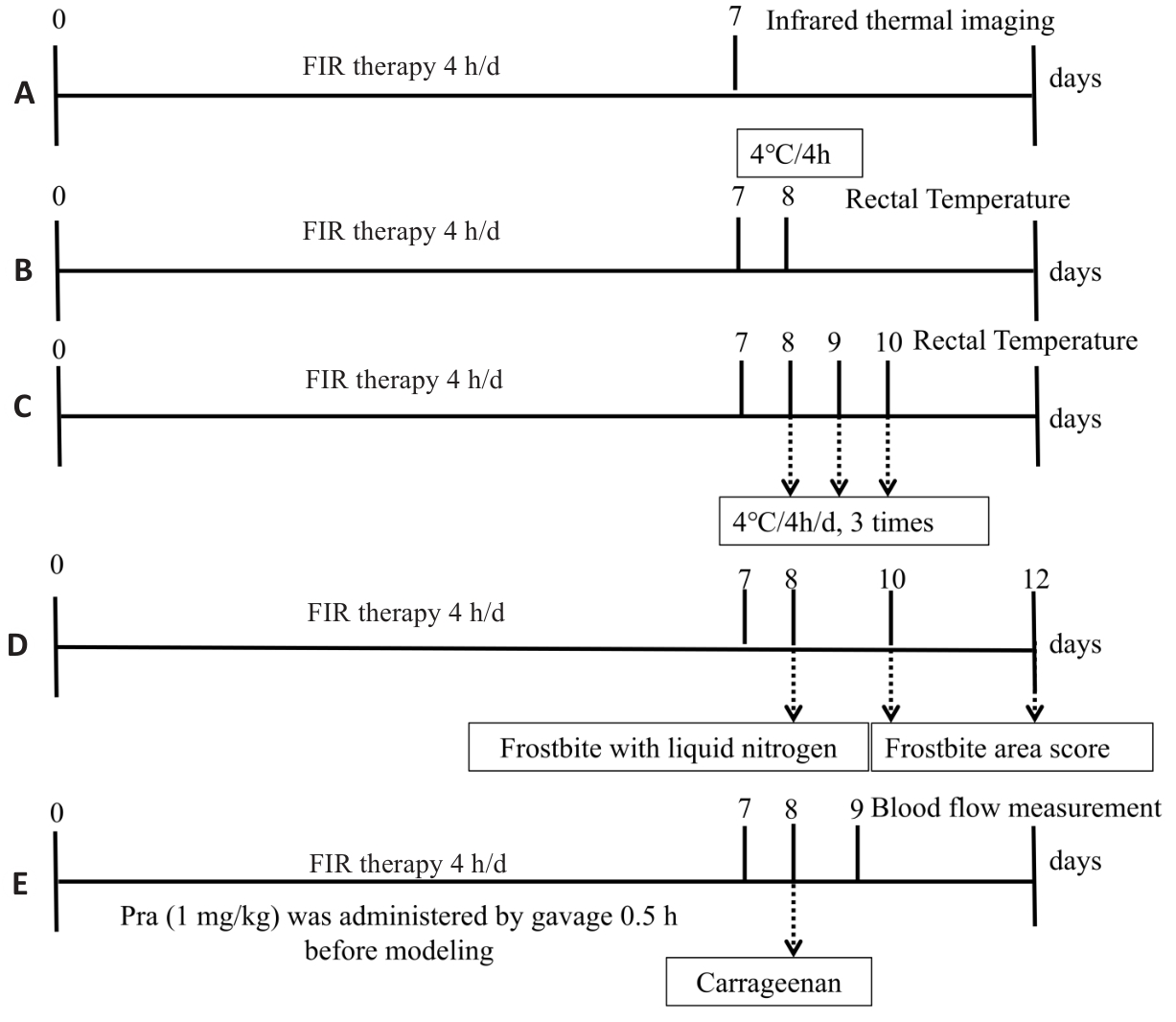
Fig. 1 Procedures of infrared thermal imaging experiment (A), acute and intermittent cold exposure experiment (B-C), liquid nitrogen frostbite experiment (D) and carrageenan-induced thrombosis experiment (E).
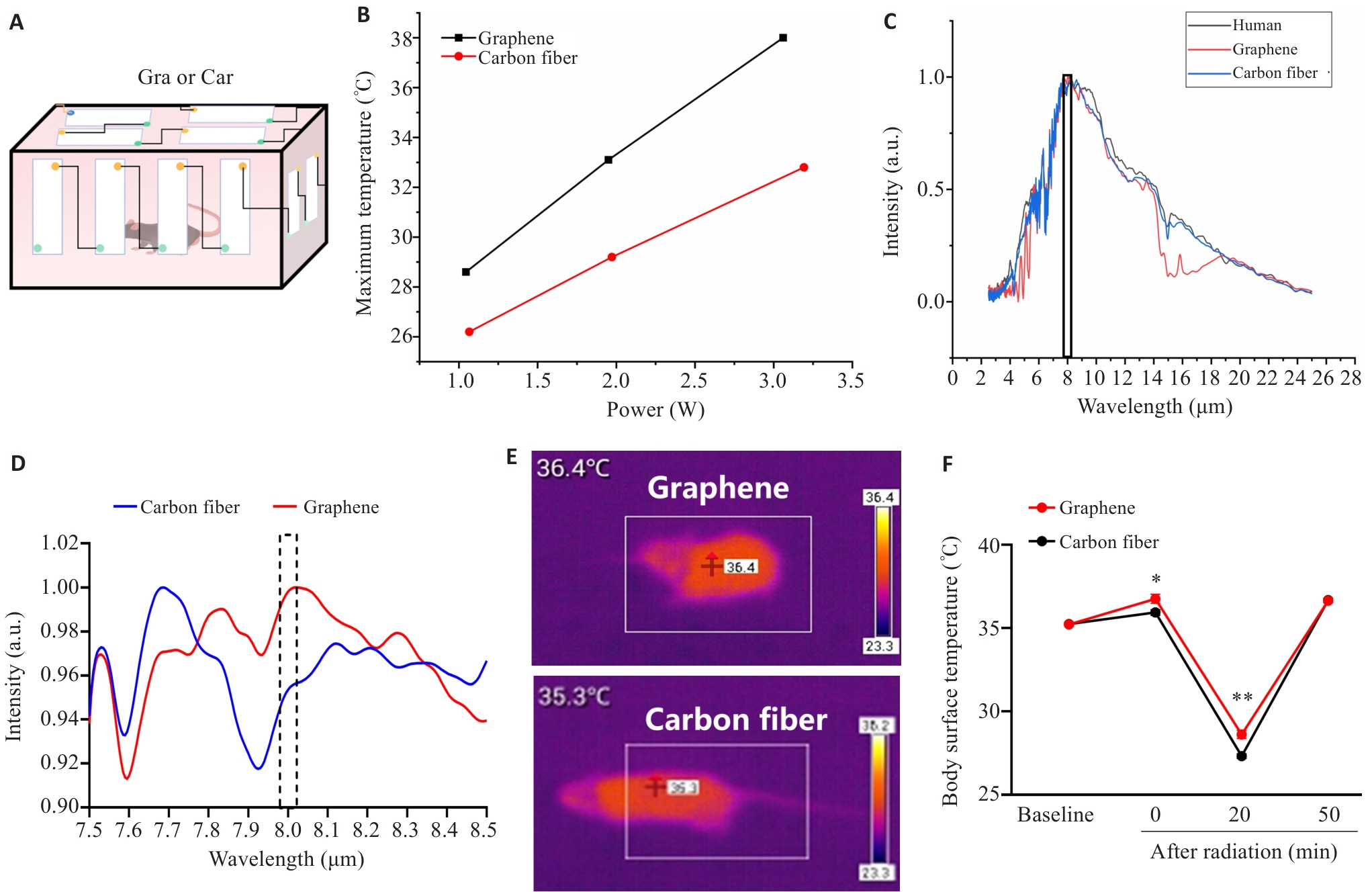
Fig. 2 Characterization of properties of graphene and carbon fiber materials. A: Schematic diagram of FIR device. B: Electrothermal properties of graphene and carbon fiber. C: Absorption peak of the human body surface (8.0 µm) and FIR emission peaks of graphene (8 µm) and carbon fiber (7.6 µm). D: Peak comparison of graphene, carbon fiber and human body at 7.5-8.5 µm wavelength (graphene: 1.9 W, carbon fiber: 1.9 W). E, F: Surface temperature changes and analysis of graphene-FIR and carbon fiber-FIR mice after irradiation. *P<0.05, **P<0.01 between the two groups.

Fig.3 Rectal temperature of mice after acute (A) and intermittent cold exposure (B). *P<0.05, **P<0.01 vs NC group, ##P<0.01 vs model group; $$P<0.01 vs Car group.

Fig. 4 Frostbite in the dorsal skin of the mice and temperature changes in the frostbite area (A) and comparison of wound temperatures among the 3 groups (B). ##P<0.01 vs model group.
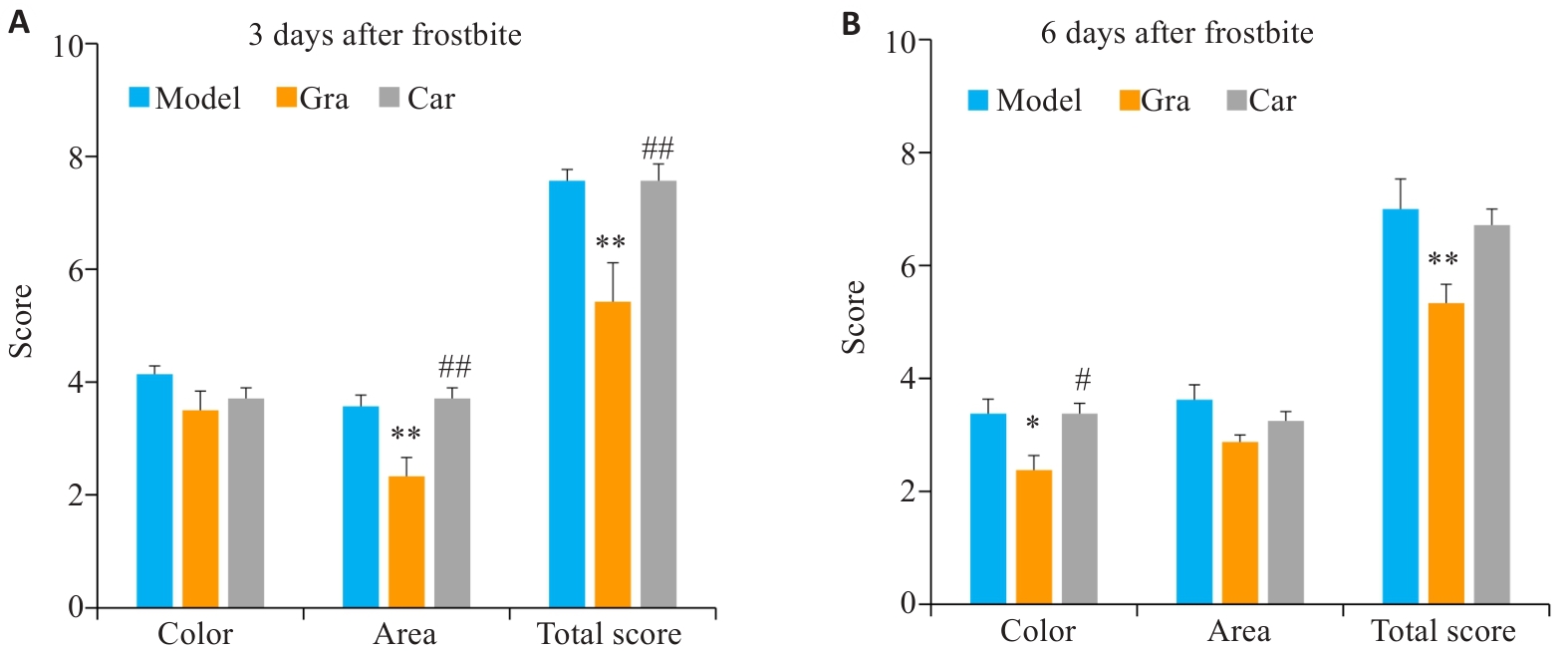
Fig.5 Changes in apparent score of frostbite area in the mice on the 3rd day (A) and 6th day (B) after frostbite. *P<0.05, **P<0.01 vs model group; #P<0.05, ##P<0.01 vs Gra group.

Fig. 6 Thrombus in the tail of the mice (A) and comparison of the length of thrombus among the 4 groups (B). **P<0.01 vs NC group; #P<0.05 vs Model group.
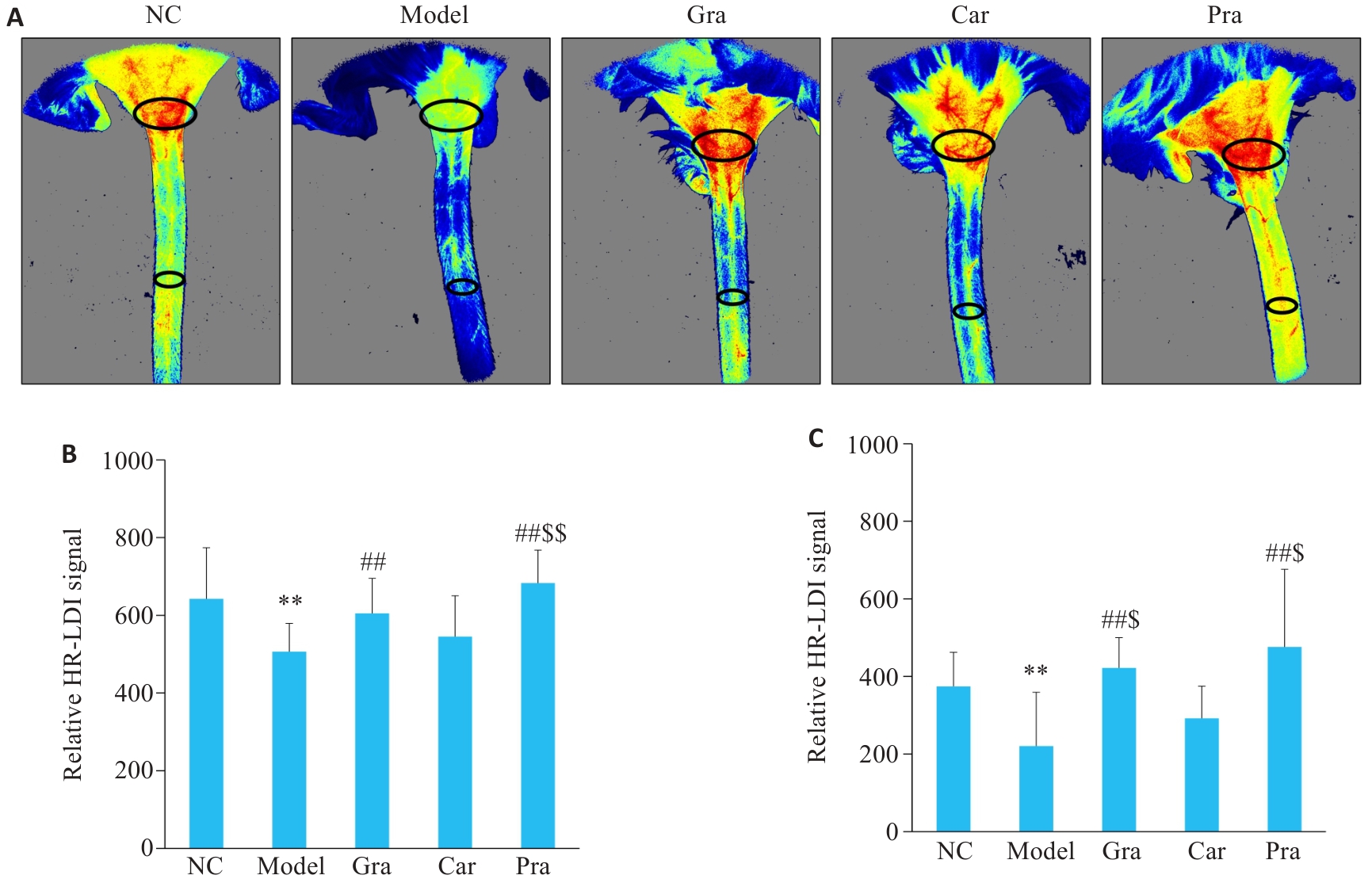
Fig. 7 Blood perfusion images of the mouse tails (A) and comparison of blood perfusion parameters at the root (B) and tail (C) among the 5 groups. **P<0.01 vs NC group; ##P<0.01 vs Model group; $P<0.05, $$P<0.01 vs Car group.
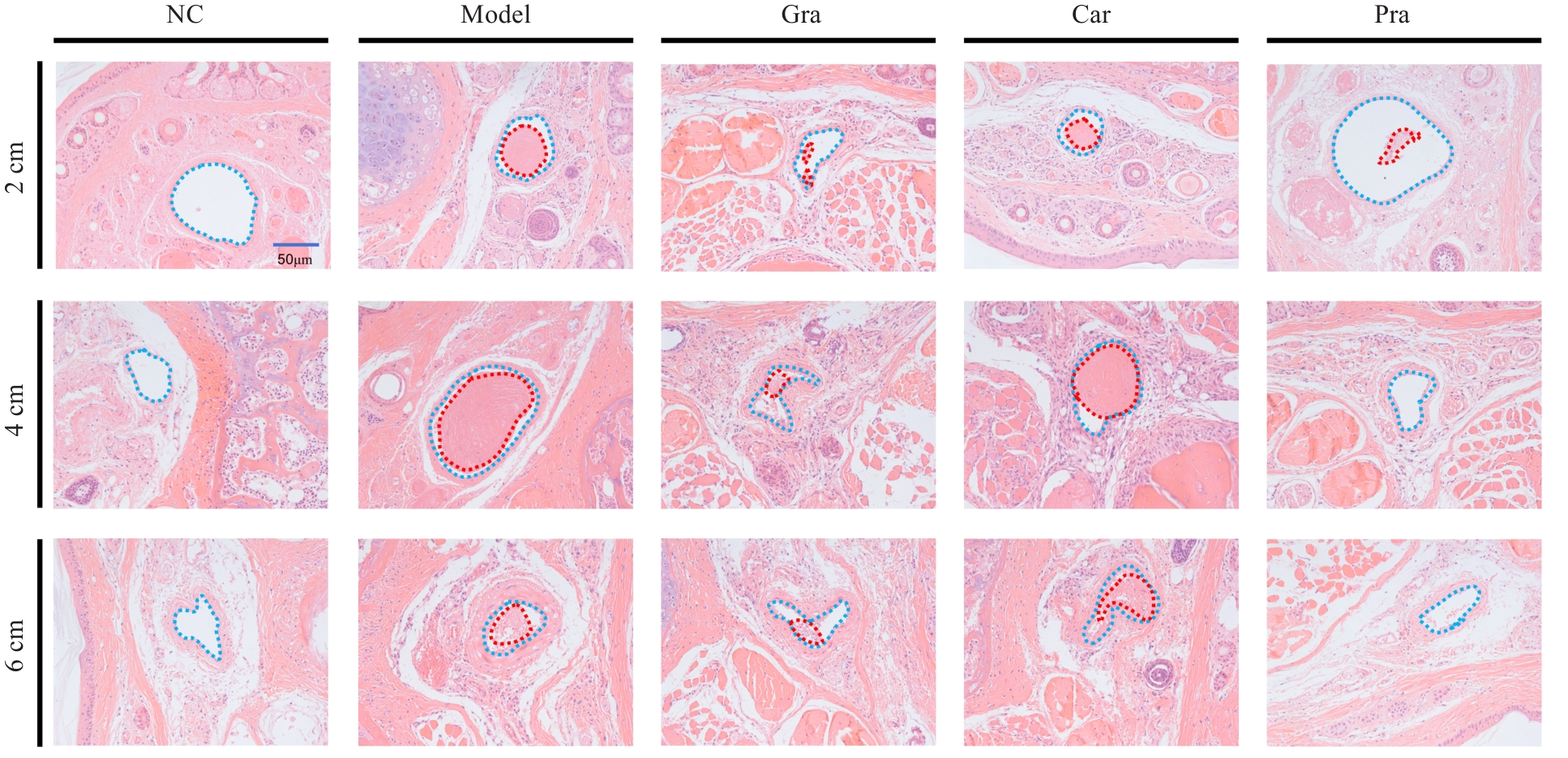
Fig. 8 HE staining of the tissues of mouse tails taken at 2, 4, and 6 cm from the tail tip in each group (Original magnification: ×200). The blue and red dotted lines show the vessel profile and the thrombi formed in the vein, respectively.
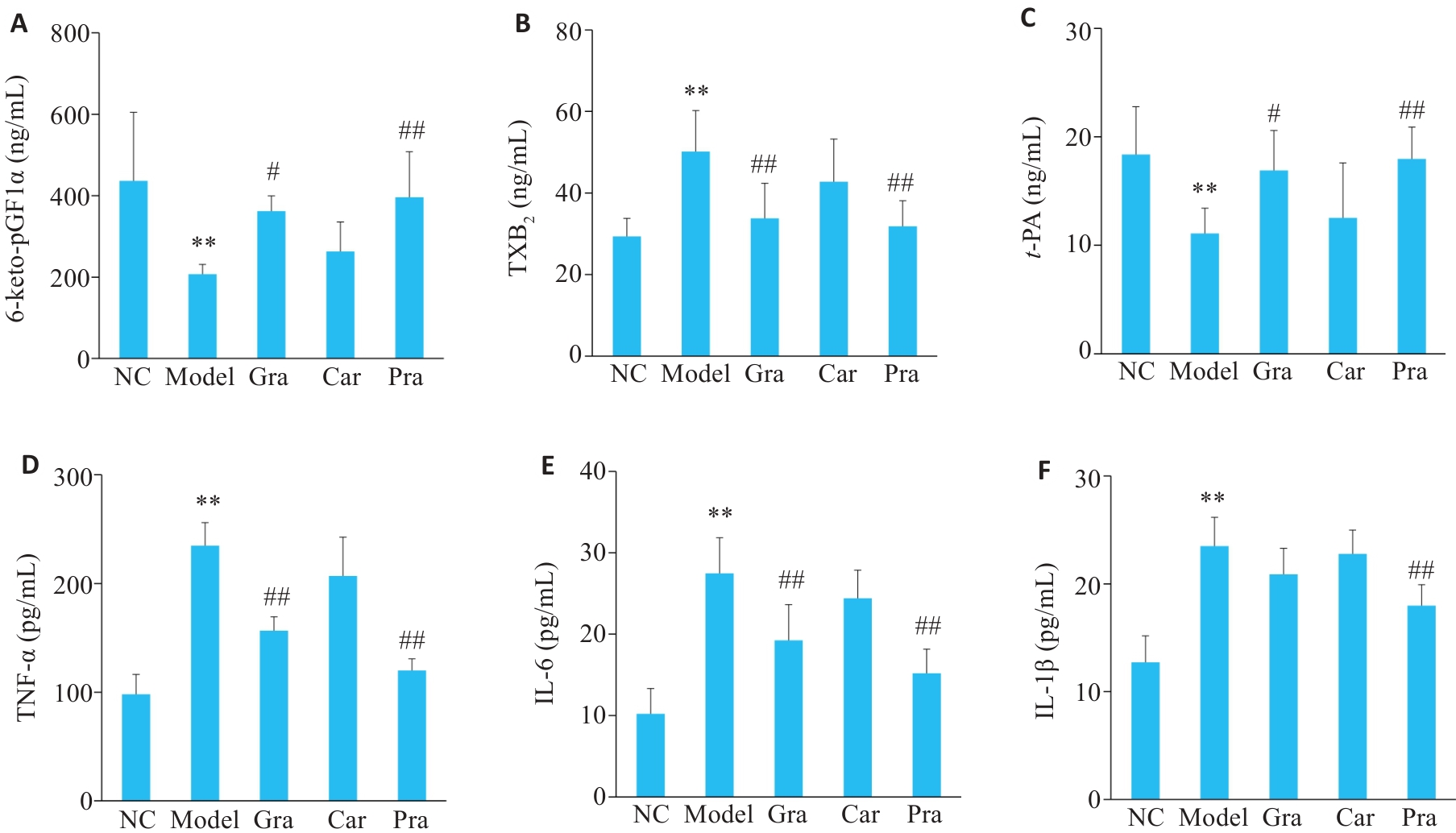
Fig. 9 Changes of serum thrombus factors 6-keto-PGF1α, TXB2 and t-PA (A-C) and the inflammatory factors TNF-α, IL-6 and IL-1β (D-F). **P<0.01 vs NC group; #P<0.05, ##P<0.01 vs Model group.
| 1 | Indo HP, Yen HC, Nakanishi I, et al. A mitochondrial superoxide theory for oxidative stress diseases and aging[J]. J Clin Biochem Nutr, 2015, 56(1): 1-7. |
| 2 | Goglia F, Liverini G, De Leo T, et al. Thyroid state and mitochondrial population during cold exposure[J]. Pflugers Arch, 1983, 396(1): 49-53. |
| 3 | Hess KL, Wilson TE, Sauder CL, et al. Aging affects the cardiovascular responses to cold stress in humans[J]. J Appl Physiol, 2009, 107(4): 1076-82. |
| 4 | Duncko R, Johnson L, Merikangas K, et al. Working memory performance after acute exposure to the cold pressor stress in healthy volunteers[J]. Neurobiol Learn Mem, 2009, 91(4): 377-81. |
| 5 | 苗艳丰, 卫 贺, 李 诚, 等. 干姜干热药性活性分子的筛选与抗小鼠低温冻伤的甲状腺氧化应激保护作用机制[J]. 中草药, 2022, 53(17): 5379-88. |
| 6 | Sheridan RL, Goverman JM, Gregory Walker T. Diagnosis and treatment of frostbite[J]. N Engl J Med, 2022, 386(23): 2213-20. |
| 7 | Hsu YH, Chen YC, Chen YW, et al. Far-infrared radiation prevents decline in β-cell mass and function in diabetic mice via the mitochondria-mediated Sirtuin1 pathway[J]. Metabolism, 2020, 104: 154143. |
| 8 | Sharma N, Shin EJ, Kim NH, et al. Protective potentials of far-infrared ray against neuropsychotoxic conditions[J]. Neurochem Int, 2019, 122: 144-8. |
| 9 | Yu TT, Hu YM, Feng GP, et al. A graphene-based flexible device as a specific far-infrared emitter for noninvasive tumor therapy[J]. Adv Ther, 2020, 3(3): 1900195. |
| 10 | Zhang JS, Li S, Cheng X, et al. Far-infrared therapy based on graphene ameliorates high-fat diet-induced anxiety-like behavior in obese mice via alleviating intestinal barrier damage and neuroinflammation[J]. Neurochem Res, 2024, 49(7): 1735-50. |
| 11 | Li S, Miao XY, Zhang JS, et al. Far-infrared therapy promotes exercise capacity and glucose metabolism in mice by modulating microbiota homeostasis and activating AMPK[J]. Sci Rep, 2024, 14(1): 16314. |
| 12 | Lee H, Choi TK, Lee YB, et al. A graphene-based electrochemical device with thermoresponsive microneedles for diabetes monitoring and therapy[J]. Nat Nanotechnol, 2016, 11(6): 566-72. |
| 13 | Inoue SI, Emmett MJ, Lim HW, et al. Short-term cold exposure induces persistent epigenomic memory in brown fat[J]. Cell Metab, 2024, 36(8): 1764-78.e9. |
| 14 | 苗明三, 项丽玲, 白 明, 等. 冻伤动物模型制备规范(草案)[J]. 中国中药杂志, 2018, 43(2): 410-4. |
| 15 | Meng ZW, Wang SN, Chen FR, et al. Discovery of highly selective, potent, covalent, and orally bioavailable factor XIIa inhibitors for the treatment of thrombo-inflammation[J]. J Med Chem, 2024, 67(13): 10946-66. |
| 16 | Qin B, Fu SJ, Xu XF, et al. Far-infrared radiation and its therapeutic parameters: a superior alternative for future regenerative medicine?[J]. Pharmacol Res, 2024, 208: 107349. |
| 17 | Kowaltowski AJ. Cold exposure and the metabolism of mice, men, and other wonderful creatures[J]. Physiology, 2022, 37(5): 0. |
| 18 | Cheng YC, Lung CW, Jan YK, et al. Evaluating the far-infrared radiation bioeffects on micro vascular dysfunction, nervous system, and plantar pressure in diabetes mellitus[J]. Int J Low Extrem Wounds, 2020, 19(2): 125-31. |
| 19 | EricDrinkwater. Thermoregulation and Human Performance [M]. Basel: KARGER, 2008: 74-88. |
| 20 | 王洪瑾, 李 毅, 冯艳萍, 等. 红景天苷对慢性低氧后冻伤大鼠血管内皮细胞的保护作用[J]. 中国应用生理学杂志, 2022, 38(6): 664-9. |
| 21 | Geng Q, Holmér I, Hartog DEA, et al. Temperature limit values for touching cold surfaces with the fingertip[J]. Ann Occup Hyg, 2006, 50(8): 851-62. |
| 22 | 宋晓丹, 成秀梅, 周 湘, 等. 寒凝血瘀证动物模型研究现状[J]. 中国实验方剂学杂志, 2022, 28(15): 267-74. |
| 23 | Sun SW, Ding CB, Liu XL, et al. Silk protein/polyvinylpyrrolidone nanofiber membranes loaded with puerarin accelerate wound healing in mice by reducing the inflammatory response[J]. Biomater Adv, 2022, 135: 212734. |
| 24 | Li MQ, Tang XP, Liao ZY, et al. Hypoxia and low temperature upregulate transferrin to induce hypercoagulability at high altitude[J]. Blood, 2022, 140(19): 2063-75. |
| 25 | Sumner DS, Boswick JA Jr, Doolittle WH. Prediction of tissue loss in human frostbite with xenon-133[J]. Surgery, 1971, 69(6): 899-903. |
| 26 | Weatherley-white RC, Sjostrom B, Paton BC. Experimental studies in cold injury. ii. the pathogenesis of frostbite[J]. J Surg Res, 1964, 4: 17-22. |
| 27 | Li Q, Chen Y, Zhao D, et al. LongShengZhi Capsule reduces carrageenan-induced thrombosis by reducing activation of platelets and endothelial cells[J]. Pharmacol Res, 2019, 144: 167-80. |
| 28 | Wang TB, Guan RM, Xia F, et al. Curcumin promotes venous thrombi resolve process in a mouse deep venous thrombosis model via regulating miR-499[J]. Microvasc Res, 2021, 136: 104148. |
| 29 | Li Q, Chen Y, Zhao D, et al. NaoXinTong capsule inhibits carrageenan-induced thrombosis in mice[J]. J Cardiovasc Pharmacol, 2018, 72(1): 49-59. |
| 30 | Lu GJ, Guo HT, Zhang Y, et al. Graphene far-infrared irradiation can effectively relieve the blood pressure level of rat untr-HT in primary hypertension[J]. Int J Mol Sci, 2024, 25(12): 6675. |
| [1] | Zhengyuan FAN, Zihan SHEN, Ya LI, Tingting SHEN, Gaofeng LI, Suyun LI. Protective effect of Bufei Yishen Formula against cigarette smoke extract-induced human bronchial epithelial cell damage and its mechanism [J]. Journal of Southern Medical University, 2025, 45(7): 1372-1379. |
| [2] | Liming WANG, Hongrui CHEN, Yan DU, Peng ZHAO, Yujie WANG, Yange TIAN, Xinguang LIU, Jiansheng LI. Yiqi Zishen Formula ameliorates inflammation in mice with chronic obstructive pulmonary disease by inhibiting the PI3K/Akt/NF-κB signaling pathway [J]. Journal of Southern Medical University, 2025, 45(7): 1409-1422. |
| [3] | Xinheng WANG, Xiaohan SHAO, Tongtong LI, Lu ZHANG, Qinjun YANG, Weidong YE, Jiabing TONG, Zegeng LI, Xiangming FANG. Pingchuanning Formula suppresses airway inflammation in a rat model of asthmatic cold syndrome by regulating the HMGB1/Beclin-1 axis-mediated autophagy [J]. Journal of Southern Medical University, 2025, 45(6): 1153-1162. |
| [4] | Yang YANG, Kai WANG, Jianxiu LIU, Zhimo ZHOU, Wen JIA, Simou WU, Jinxing LI, Fang HE, Ruyue CHENG. Early life Bifidobacterium bifidum BD-1 intervention alleviates hyperactivity of juvenile female rats with attention deficit hyperactivity disorder [J]. Journal of Southern Medical University, 2025, 45(4): 702-710. |
| [5] | Xianheng ZHANG, Jian LIU, Qi HAN, Yiming CHEN, Xiang DING, Xiaolu CHEN. Huangqin Qingrechubi Capsule alleviates inflammation and uric acid and lipid metabolism imbalance in rats with gouty arthritis by inhibiting the PTEN/PI3K/AKT signaling pathway [J]. Journal of Southern Medical University, 2024, 44(8): 1450-1458. |
| [6] | Yuming ZHANG, Shicheng XIA, Linlin ZHANG, Mengxi CHEN, Xiaojing LIU, Qin GAO, Hongwei YE. Protective effect of Lonicerae japonicae flos extract against doxorubicin-induced liver injury in mice [J]. Journal of Southern Medical University, 2024, 44(8): 1571-1581. |
| [7] | Shan XIANG, Zongxing ZHANG, Lu JIANG, Daozhong LIU, Weiyi LI, Zhuoma BAO, Rui TIAN, Dan CHENG, Lin YUAN. Tujia medicine Toddalia asiatica improves synovial pannus in rats with collagen-induced arthritis through the PI3K/Akt signaling pathway [J]. Journal of Southern Medical University, 2024, 44(8): 1582-1588. |
| [8] | Linyu XIAO, Ting DUAN, Yongsheng XIA, Yue CHEN, Yang SUN, Yibo XU, Lei XU, Xingzhou YAN, Jianguo HU. Linarin inhibits microglia activation-mediated neuroinflammation and neuronal apoptosis in mouse spinal cord injury by inhibiting the TLR4/NF-κB pathway [J]. Journal of Southern Medical University, 2024, 44(8): 1589-1598. |
| [9] | Huaixiang TAO, Jinguang LUO, Zhiyuan WEN, Genming YU, Xiao SU, Xinwei WANG, Han GUAN, Zhijun CHEN. High STING expression exacerbates renal ischemia-reperfusion injury in mice by regulating the TLR4/NF-κB/NLRP3 pathway and promoting inflammation and apoptosis [J]. Journal of Southern Medical University, 2024, 44(7): 1345-1354. |
| [10] | Zhixian REN, Beixian ZHOU, Linxin WANG, Jing LI, Rongping ZHANG, Xiping PAN. Inhibitory effect of 5-hydroxy-6,7-dimethoxyflavone on H1N1 influenza virus-induced ferroptosis and inflammation in A549 cells and its possible mechanisms [J]. Journal of Southern Medical University, 2024, 44(6): 1070-1078. |
| [11] | CAO Jiafan, SUN Yue, DING Xin, LI Shengwen, CHEN Bo, LAN Tian. Arbutin ameliorates liver fibrosis in mice by inhibiting macrophage recruitment and regulating the Akt/NF-κB and Smad signaling pathways [J]. Journal of Southern Medical University, 2024, 44(4): 652-659. |
| [12] | XI Jin, ZHANG Min, ZHANG Yongyu, ZHANG Chen, ZHANG Yulu, WANG Rui, SHEN Lin, LI Jing, SONG Xue. Upregulating KLF11 ameliorates intestinal inflammation in mice with 2, 4, 6-trinitrobenesulfonic acid-induced colitis by inhibiting the JAK2/STAT3 signaling pathway [J]. Journal of Southern Medical University, 2024, 44(4): 765-772. |
| [13] | WU Guangyang, SONG Tianli, TANG Lang, WANG Yiming, LIU Xu, HUANG Sheng. Total saponins of Panax japonicus alleviates CCl4-induced acute liver injury in rats by regulating the PI3K/AktNF-κB signaling pathway [J]. Journal of Southern Medical University, 2024, 44(2): 244-251. |
| [14] | WU Ruojie, LIU Rui, ZHANG Yisu, LI Xiaohong. Parecoxib sodium down-regulates CXCL8-CXCR1/2 to improve inflammatory microenvironment and promote patient recovery following laparoscopic radical resection of rectal cancer [J]. Journal of Southern Medical University, 2024, 44(2): 363-369. |
| [15] | Chengcheng JIANG, Yangyang LI, Kexin DUAN, Tingting ZHAN, Zilong CHEN, Yongxue WANG, Rui ZHAO, Caiyun MA, Yu GUO, Changqing LIU. Parkin deletion affects PINK1/Parkin-mediated mitochondrial autophagy to exacerbate neuroinflammation and accelerate progression of Parkinson's disease in mice [J]. Journal of Southern Medical University, 2024, 44(12): 2359-2366. |
| Viewed | ||||||
|
Full text |
|
|||||
|
Abstract |
|
|||||